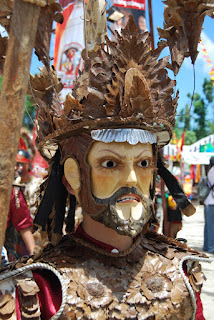



In the early 60's moryonan, as what the people called the moriones tradition then, attracted the world outside because it WAS the only known Filipino folk tradition that made use of masks. Most of the masks then were made of “dapdap”, Indian coral tree, a thorny softwood tree that grew abundantly everywhere on the island. (In summertime when their flowers would bloom, local fisherfolks would be pleased because this was a positive sign - the period for huge catches. They were never wrong).
It was common for children in those days to call most of these masked men, (or women sometimes), “moryong tanga”, stupid moryon, because those early masks did have that blank stupid look. The masks used to be washed out with pink paint, had huge eyes and high pointed noses that hardly depicted the pango Filipino nose.
Turbantes, headresses, were decorated with flowers made of crepe paper, cigarette foil or papel de hapon, japanese paper. "Bulaklakan" they were called. The number of flowers were usually seven, (the association of seven with magic – 7 days a week, ‘siete palabras’, seven last words, is perhaps an explanation for that), and it indicated the number of years one would become a moryon as his or her personal panata, vow. Then one would find fullfilment and inner peace thereafter.
Today's morion masks and turbantes reflect a greater sense of beauty and competition as shown in this year's entries. Folk art evolves and survives, thus, in Marinduque.










No comments:
Post a Comment